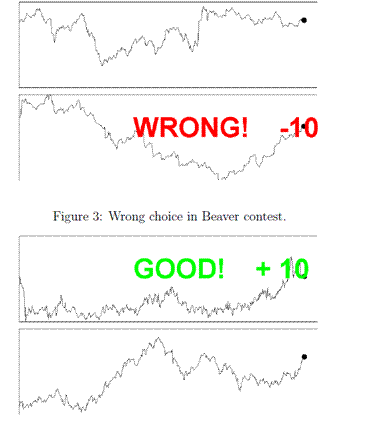Turing financial test for pattern search
A group of economists from MIT, Cambridge, and Northeastern University launched a simple experiment called the Turing financial test . There are two graphics to choose from: one real, and the second the same numbers, but mixed randomly.

Try to determine by eye and see how your results in the long run will differ from 50%.
The meaning of this fun is. Some economists believe that the effectiveness of the free market can be judged by its specific results. The more random the prices over a certain period of time, the more efficient the market. There should not be any patterns or predictable movements. The ideal market, according to their theory, should be completely random, completely unpredictable.
')
In this regard, the question arises: what do we have today? We have an interesting situation. In global markets (gold, foreign exchange market) prices are unpredictable, it is a fact. At any time, the trend can go up or down, as the casino drops red or black. But are these unpredictable movements random? That is the question. Are there any characteristic patterns recognizable by man in the market movements? The results of the "Turing financial test" should answer this question.
UPD. By the way, the first results are already there: people guess the correct schedule by 0.5 percentage points. more often than wrong. That is a ratio of about 50.25% to 49.75%. Probably, the test was simply poorly programmed and some unnatural jumps on the graph are just strongly striking.
via the physics arXiv blog

Try to determine by eye and see how your results in the long run will differ from 50%.
The meaning of this fun is. Some economists believe that the effectiveness of the free market can be judged by its specific results. The more random the prices over a certain period of time, the more efficient the market. There should not be any patterns or predictable movements. The ideal market, according to their theory, should be completely random, completely unpredictable.
')
In this regard, the question arises: what do we have today? We have an interesting situation. In global markets (gold, foreign exchange market) prices are unpredictable, it is a fact. At any time, the trend can go up or down, as the casino drops red or black. But are these unpredictable movements random? That is the question. Are there any characteristic patterns recognizable by man in the market movements? The results of the "Turing financial test" should answer this question.
UPD. By the way, the first results are already there: people guess the correct schedule by 0.5 percentage points. more often than wrong. That is a ratio of about 50.25% to 49.75%. Probably, the test was simply poorly programmed and some unnatural jumps on the graph are just strongly striking.
via the physics arXiv blog
Source: https://habr.com/ru/post/85783/
All Articles